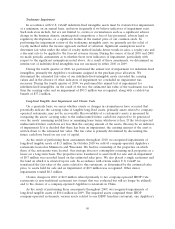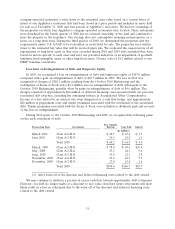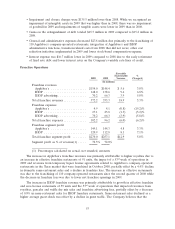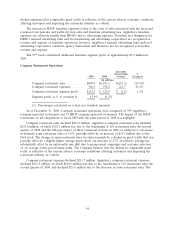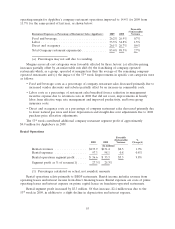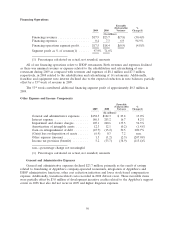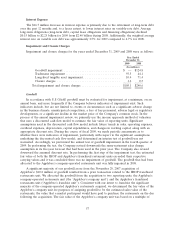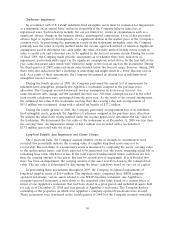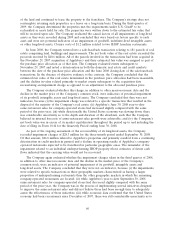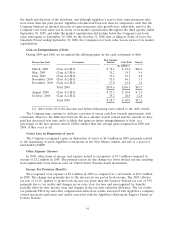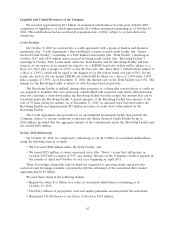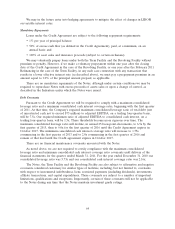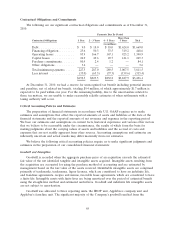IHOP 2010 Annual Report Download - page 75
Download and view the complete annual report
Please find page 75 of the 2010 IHOP annual report below. You can navigate through the pages in the report by either clicking on the pages listed below, or by using the keyword search tool below to find specific information within the annual report.Tradename Impairment
In accordance with U.S. GAAP, indefinite-lived intangible assets must be evaluated for impairment,
at a minimum, on an annual basis, and more frequently if the Company believes indicators of
impairment exist. Such indicators include, but are not limited to, events or circumstances such as a
significant adverse change in the business climate, unanticipated competition, a loss of key personnel,
adverse legal or regulatory developments, or a significant decline in the market price of the Company’s
common stock. In performing the impairment review of the tradename intangible asset, the Company
primarily uses the relief of royalty method under the income approach method of valuation. Significant
assumptions used to determine fair value under the relief of royalty method include future trends in
sales, a royalty rate and a discount rate to be applied to the forecast revenue stream. During the course
of fiscal 2009, the Company made periodic assessments as to whether there were indicators of
impairment, particularly with respect to the significant assumptions noted above. In the first half of the
year, same-restaurant sales trends were within the range of the forecast used in the assessment. During
the third quarter of 2009, same-restaurant sales trended below the forecast range; however, during 2009
there were also indications that a lessening of underlying risk might result in a lower discount rate as
well. As a result of these assessments, the Company determined an interim test of indefinite-lived
intangibles was not necessary.
During the fourth quarter of 2009, the Company performed the annual test of impairment for
indefinite-lived intangibles, primarily the Applebee’s tradename assigned in the purchase price
allocation. The Company revised downwards two key assumptions in its five-year forecast: the
same-restaurant sales change and the assumed discount rate. All other assumptions used in the relief
from royalty calculation were unchanged from the prior year. As the result of the revised assumptions,
the estimated fair value of the tradename was less than the carrying value and an impairment of
$93.5 million was recognized, along with a related tax benefit of $37.2 million.
During the fourth quarter of 2008, the Company performed an impairment test of its indefinite-
lived intangible assets, primarily the Applebee’s tradename assigned in the purchase price allocation.
We utilized the relief from royalty method under the income approach to determine the fair value of
the tradename. We determined the fair value of the tradename as of December 31, 2008 was less than
the carrying value. An impairment charge of $44.1 million was recorded with a tax benefit of
$17.3 million associated with the charge.
Long-lived Tangible Asset Impairment and Closure Charges
On a quarterly basis, the Company assesses whether events or changes in circumstances have
occurred that potentially indicate the carrying value of tangible long-lived assets may not be
recoverable. Recoverability of a restaurant’s assets is measured by comparing the assets’ carrying value
to the undiscounted future cash flows expected to be generated over the assets’ remaining useful life or
remaining lease term, whichever is less. If the total expected undiscounted future cash flows are less
than the carrying amount of the assets, this may be an indicator of impairment. If it is decided that
there has been an impairment, the carrying amount of the asset is written down to the estimated fair
value. The fair value is determined by discounting the future cash flows based on our cost of capital.
In performing these assessments throughout 2009, the Company recognized impairments of
long-lived tangible assets of $10.4 million. The impaired assets comprised three IHOP company-
operated restaurants, various assets related to one IHOP franchise restaurant, one Applebee’s
company-operated restaurant, a write-down to the estimated sales value based on a current letter of
intent of one Applebee’s restaurant that had been closed in a prior period and included in assets held
for sale as of December 31, 2008 and four parcels of Applebee’s real estate. The Company had fee
ownership of the properties on which four Applebee’s company-operated restaurants were located.
These restaurants were franchised in the fourth quarter of 2008 but the Company retained ownership
59



